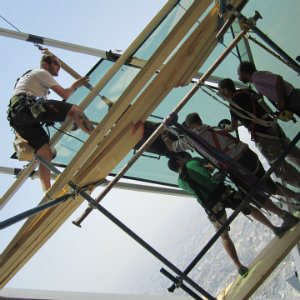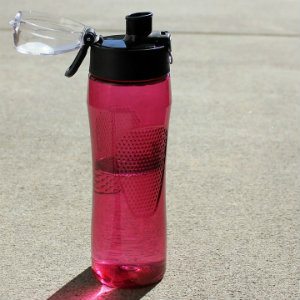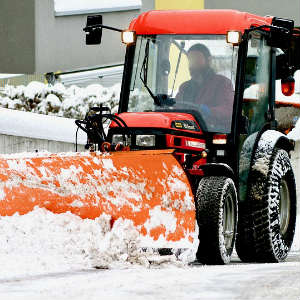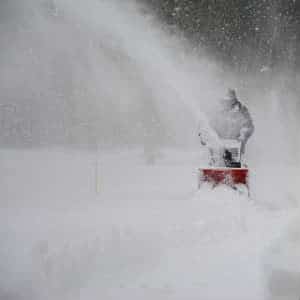Time and time again our lawyers have seen cases where workers were expected to do their jobs during extreme weather conditions, only to end up injured. Like any other work injury, workers’ compensation does provide coverage for weather-related injuries. Read on to learn more.
While many people spend an entire winter talking about how they can’t wait for summer and hot weather, others, typically those who have chosen careers which require that they work outside, dread the thought of long hot days – and for good reason. While it might be nice to have a little warm weather and sunshine, too much can lead to painful and life-threatening injuries and illnesses.
How Hot Is Too Hot For Workers?
 This is a tough question to answer. Every human body is different and overall fitness, body type, and medical conditions can mean that a temperature that is comfortable for one person, may be too warm for another. Additionally, other factors in nature, such as humidity, the wind, and the amount of direct sunlight being absorbed can complicate the issue.
This is a tough question to answer. Every human body is different and overall fitness, body type, and medical conditions can mean that a temperature that is comfortable for one person, may be too warm for another. Additionally, other factors in nature, such as humidity, the wind, and the amount of direct sunlight being absorbed can complicate the issue.
For example, in order to release heat and naturally cool the body, sweat is produced as internal heat rises. That sweat then evaporates and cools the body down. On extremely humid days, the sweat may not evaporate and the body will not cool. Or, if the wind is blowing, the sweat may dry so quickly that the worker doesn’t realize they have lost a lot of fluids and are in danger of becoming seriously dehydrated on top of overheating.
Generally, anytime that someone is working in temperatures of the 70’s, 80’s, and 90’s, they should take precautions to protect themselves.
How To Stay Safe In The Heat
There are steps that anyone can take to make sure they take care of themselves while working in hot weather:
Hydrate Before Work
Being hydrated before you are in a hot environment means that you are starting out on the right foot. Drink extra fluids at night before bed and prior to work if you know you will be working in the heat.
Keep A Water Bottle Close
Most people actually forget to drink the fluids they need to replace the ones they have lost if there isn’t a physical reminder. Keep a water bottle nearby so that you are visually reminded to continue drinking.
Drink Before You Are Thirsty
Thirst is the body’s way of informing you that you are already dehydrated. Prevent this by drinking every 15-20 minutes while in the heat.
Avoid Caffeine & Alcohol
Both caffeine and alcohol are diuretics, which means that they actually contribute to dehydration.
Snack On Fruits & Veggies
Both fruits and vegetables contain large amounts of water and can help to replace lost fluids.
Adjust Your Schedule
If you are able, work during the cooler hours of the day and avoid exposure to the sun.
Choose Your Clothing Wisely
Loose clothing that is breathable is best. Additionally, there are now sweat wicking materials that were manufactured with the intent to assist people with keeping cool.
Wear SPF
Sunburn is one of the most common ways in which an employee can become injured. If severe enough, the worker can suffer from sun poisoning, which can lead to swelling, fever, nausea, dizziness, headaches, and blistering skin. Burns can be prevented by wearing the correct clothing and slathering exposed skin with SPF.
Signs of Heat Exhaustion
Be aware of the signs of heat exhaustion not just for yourself but also for coworkers. Someone who is in danger may display the following symptoms:
- Excessively pale or flushed skin
- Headaches
- Nausea
- Weakness
- Loss of consciousness
How To Assist Someone Suffering From Heat Exhaustion
If someone is displaying the above symptoms, there are several ways that you can help them.
- Move them into a cool, dry place.
- Spray them with cool water or apply cool, wet towels to the skin.
- If they are awake, give them small amounts of cool water.
If they vomit, lose consciousness, or if they seem disoriented, call 911 right away. If an overheated worker isn’t cooled down immediately, they may suffer from heat stroke which is a life-threatening condition.
Are Their OSHA Standards Regarding Heat?
Yes. Employers are responsible for ensuring that all employees are working in a safe environment. Anyone who knows that their employees are going to be exposed to high temperatures should make sure that they are able to take breaks in a cool place, have access to water, and that new employees are given time to acclimate to the new environment.
Are Heat-Related Illnesses Covered By Workers’ Compensation?
Yes. Workers’ compensation was designed to cover any accident or illness which occurs while working. This insurance may cover medical bills and even a portion of lost wages if the employee is unable to return to work for an extended period of time.
Extreme Cold: Stay Safe While Working In Winter Weather
Winter can be a magical time of year. For many, snowfall is utterly beautiful and offers an excuse for the everyday hustle and bustle of life to slow down. But for others, whose jobs are outdoors and require them to continue on even in low temperatures, putting their health at risk.
Industries That Are Most At Risk
In New York, workers in the following industries often sustain illnesses and injuries from working outside during the winter:
- Construction
- Law Enforcement
- Firefighting
- Snow Removal
- Baggage Handlers
There are steps that can be taken in order to prevent a variety of medical conditions that together are referred to as “cold stress”. Precautions include:
- Wearing multiple layers. These layers should be a bit loose, however, as tight clothing can actually reduce circulation. When circulation is reduced the body is unable to warm an appendage or organ as effectively as it should.
- Wear additional protective items on the ears, hands, feet, and face because when the body senses that it is in danger of freezing, it focuses its efforts on saving the internal organs, even if that means sacrificing a limb.
- Wear as much waterproof material as possible. Skin that is wet loses heat twenty five times faster than dry skin.
- If possible, schedule outside work while the sun is up and the weather is warmest.
- Stay hydrated. This helps the body remain energized and warm.
- Eat properly. The body burns more calories while it tries to stay warm.
But the responsibility for staying safe doesn’t lie solely with the employee. Employers are charged with making sure that each of their employees is provided with a safe environment. When it comes to winter weather, OSHA expects an employer to:
- Provide all employees with training.
- Educate them on the risks of working in cold weather and the warning signs of cold stress.
- Monitor how long an employee is outside.
- Request that all employees use the buddy system so that no one is unsupervised.
If the employer fails in their duty and an employee becomes ill or injured, there should be a workers’ compensation insurance policy to pay for their medical expenses.
What Does Workers’ Comp Cover?
Workers’ compensation insurance covers any work-related injury, including those related to working in the cold. Examples of medical conditions that workers face during the winter include:
Frostbite
Most people have heard of frostbite but shockingly, they aren’t aware of the symptoms. If a worker notices any of the following, they should seek medical attention immediately:
- numbness, tingling, or a prickly sensation in the skin
- red, white, blue, or gray skin color
- blistering once the skin as started to warm again
- or hard skin
This serious condition typically starts in the fingers, toes, the tip of the nose, and chin. If not treated immediately, the affected part may need to be amputated due to tissue death.
Hypothermia
When someone’s body begins to recognize that it is in danger of becoming too cold, it reacts by doing everything it can to keep the internal organs safe. This means that the blood vessels in the extremities constrict and oxygen flow is reduced. Once the body’s temperature reaches 95 degrees or below, brain activity slows, muscle movement is limited, and speech can become slurred. Eventually, the patient loses consciousness. If the body isn’t warmed and medical treatment obtained, the worker may freeze to death.
Trench Foot
Trench foot, which gets its name from the soldiers from World War I who fought in the trenches, happens when a worker is out in the cold and the gear they are wearing becomes damp. If the worker continues to work without warming up or drying their feet, swelling, pain, discoloration, and ulcers can occur. If not treated, permanent tissue and nerve damage may result with the need to amputate.
These conditions may result in the need for hospitalization, medications, surgery, x-rays, and other tests, all of which is coverable by workers’ compensation. In addition to this, any injuries that are caused due to the slippery nature of winter weather are also coverable. For example, if a worker slips and falls on ice and breaks a bone or if they are struck by snow falling from a roof, their medical expenses can also be covered.




